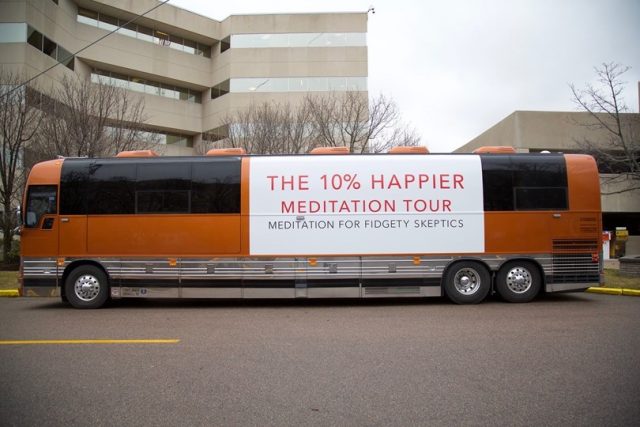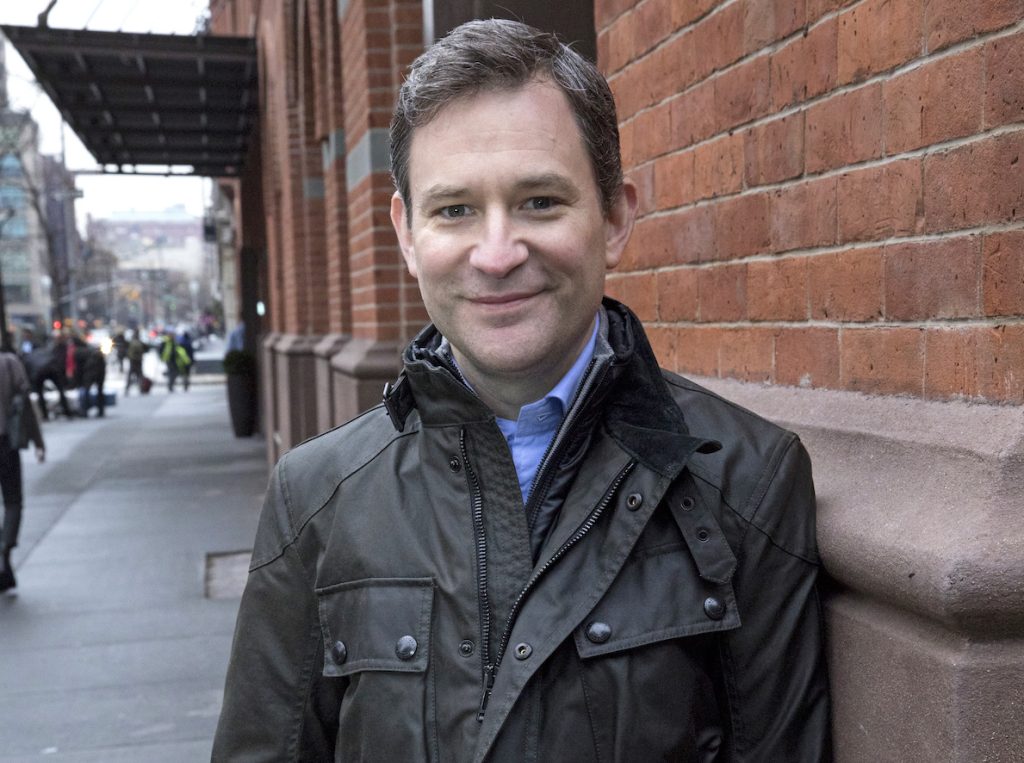Veteran ABC news anchor and self-proclaimed meditation evangelist Dan Harris is back with a second book, Meditation for Fidgety Skeptics, which has already made its way on to the New York Times bestseller list.
For his sophomore title, co-written with meditation teacher Jeff Warren and journalist Carlye Adler, Harris goes beyond “simply demystifying meditation” to a how-to format aimed at “helping people get over the [meditation] hump and actually do the thing.”

The best way to accomplish this, Harris and his 10% Happier podcast crew decide, is to embark on a 11-day cross-country journey on a rockstar tour bus (previously inhabited by the iconic seventies band Parliament-Funkadelic) in a modern version of a wandering retreat.
Meditation for Fidgety Skeptics is a combination of true stories from people who’d like to meditate but don’t know where to start, practical meditation exercises, and the self-deprecating anecdotes we’ve come to expect from Harris.
Here are five obstacles to meditating that Harris and his podcast team hear about along the way:
1. How do I find time to meditate?
On the first day of the meditation road trip, Harris is live on a Top 40 syndicated radio show when he fields a call from a high school teacher named Brian, who asks how long it actually takes to meditate—10 minutes? 15 minutes?
This important question comes up continually when Harris talks about meditation. “Once they grasp the benefits of the practice and realize that it doesn’t require clearing the mind, the next big problem is: How the hell do I fit this into my schedule?” Harris writes.
Every minute counts, according to Harris, especially if it gets you coming back to the cushion, and he usually recommends that beginners practice for 5 to 10 minutes a day. To build up the habit, co-author Jeff Warren recommends a series of “free-range meditations,” that use activities throughout your day, such as brushing your teeth or washing the dishes, as brief opportunities for practice.
2. Will people think I’m weird?
Harris and his 10% Happier crew were all set to interview park rangers at Shenandoah National Park in Virginia . . . until officials clammed up at the message that meditating federal employees might send. In a pinch, Harris called up Congressman Tim Ryan, a former quarterback, practicing Catholic, and open meditator whom Harris describes as a “one of the most normal, non-weird American male specimens you could imagine.” Ryan, who had learned the Christian centering prayer in his earlier years, turned to Mindfulness-based Stress Reduction (MBSR) as a career politician on the edge of burnout, and had a profound experience of seeing his own thoughts arise.
As for the “weirdness” factor, Ryan, who authored A Mindful Nation, says he has plenty of brain science to back up the practice—not to mention sports legends such as Michael Jordan and Kobe Bryant, who are both meditation believers. For his part, Harris writes that he’s convinced that meditation is the “next big public health revolution,” and that someday soon meditation practice will be just as mainstream as running or yoga
3. Meditation could bring up too many painful emotions.
In Las Cruces, New Mexico, Dan and Jeff visit with therapists and social workers who work with disadvantaged children living with disabilities. Though meditation was encouraged by management, many of the staff members were afraid that looking inward could lead to an avalanche of difficult emotions. Physical therapist Zoe Gutierrez said she loves her challenging work, but says she’s more inclined to shut down after work than to reflect on the situations she sees every day.
Instead of sweeping emotions further under the rug, meditation can help us address them proactively, Harris writes, adding that practice helps us “see them clearly rather than having them sally forth from their dark mental redoubts at a time of their choosing.” The exception, they write, is for people suffering from trauma, who are advised to speak with a mental health practitioner before beginning a meditation practice.
4. Meditation could make me too soft.
Cruising around the streets of Tempe, Arizona, Harris introduces us to Sergeant Raj Johnson. Reflecting on the ever-present danger associated with the profession, as well as the negative attitudes toward police in the United States over the past few years, Johnson says he’s apprehensive that meditation could slow him down and affect his abilities to make split-second decisions.
Johnson doesn’t have much of a choice when it comes to meditation, because his boss, Tempe Chief of Police Sylvia Moir, encourages her officers to practice, and has them trained in “combat breathing”— a deep breathing technique that can be used during or on the way to tense situations. And, Harris adds in the book, research shows that meditation can help people with dangerous jobs have better working memory, a lower level of cortisol release, and improved recovery time. In Harris’ words: meditation can give you an “edge” without the “edginess.”
5. Something else is my meditation.
At the East Hollywood offices of InsideOUT Writers, a nonprofit that pairs professional writers with formerly incarcerated young people, Dan and Jeff lead a concentration meditation for the participants, followed by a writing session on their worries. We meet Mylrell Miner, who has a baby on the way and a broken-down car to fix, and Candice Price, who is feeling the pressure to take care of multiple family members who have recently been released from jail.
Dan writes that he found the participants’ stories incredibly moving, and recognized that as a group they’re practicing a lot of the skills that meditation practice can cultivate, such as exploring strong emotions and treating others with compassion.
When it comes to other activities, such as martial arts or running, replacing a formal sitting practice, Warren explains that meditation is like “life skills for dummies”—you can tune in and practice any activity mindfully. If you want to practice while you jog, Warren recommends setting a meditation time within the activity time and committing to being fully present (so no music or podcasts).
Meditation for Fidgety Skeptics is now available from Spiegel & Grau.
Thank you for subscribing to Tricycle! As a nonprofit, we depend on readers like you to keep Buddhist teachings and practices widely available.
